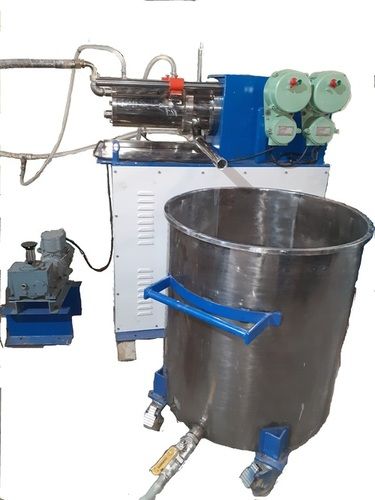
उत्पाद विवरण:
मूल्य और मात्रा
- 1
व्यापार सूचना
- प्रति महीने
- दिन
उत्पाद वर्णन
A Vertical Sand Mill is a type of grinding machine used for the dispersion and fine grinding of materials in industries such as paints, coatings, inks, and pigments. It is designed with a vertically oriented grinding chamber where the grinding media, typically beads, are agitated by a rotating shaft to break down and disperse particles. The vertical orientation allows for a more efficient grinding process as gravity aids in the movement of the materials, leading to a consistent and uniform particle size distribution.
Vertical sand mills are preferred in applications where fine and controlled particle size is crucial. They offer several advantages, such as ease of operation, better cooling due to the vertical design, and minimal contamination risk since the grinding chamber is sealed. The mills are capable of handling both low and high-viscosity products, making them versatile for various industrial applications.
FAQs for Vertical Sand Mill
1. What are the primary applications of a Vertical Sand Mill?
Vertical Sand Mills are primarily used in the production of paints, coatings, inks, pigments, and other materials that require fine and uniform particle size distribution.
2. How does a Vertical Sand Mill differ from a Horizontal Sand Mill?
The main difference is the orientation of the grinding chamber. In a Vertical Sand Mill, the chamber is oriented vertically, which allows gravity to assist in the grinding process, often resulting in more efficient operation. In contrast, a Horizontal Sand Mill has a horizontal chamber that requires a different type of agitation and may offer different advantages depending on the application.
3. What are the benefits of using a Vertical Sand Mill?
Benefits include efficient particle size reduction, ease of operation, better cooling due to vertical design, reduced contamination risk, and the ability to handle both low and high-viscosity products.
4. What types of materials can be processed in a Vertical Sand Mill?
A Vertical Sand Mill can process a variety of materials, including paints, coatings, inks, pigments, and other materials that require fine grinding and dispersion.
5. How does the cooling system in a Vertical Sand Mill work?
The cooling system in a Vertical Sand Mill typically involves circulating coolant through the mill's jacket, which surrounds the grinding chamber. This helps to dissipate the heat generated during the grinding process, maintaining a stable temperature and protecting heat-sensitive materials.
6. What is the typical particle size range achievable with a Vertical Sand Mill?
The particle size range achievable with a Vertical Sand Mill typically ranges from a few microns to sub-micron levels, depending on the material and process parameters.
7. How do you maintain a Vertical Sand Mill?
Maintenance of a Vertical Sand Mill includes regular cleaning of the grinding chamber, checking and replacing worn grinding media, ensuring the cooling system functions properly, and inspecting mechanical seals and other components for wear.
8. Can a Vertical Sand Mill be used for both batch and continuous processes?
Yes, a Vertical Sand Mill can be used for both batch and continuous processes, depending on the specific design and configuration of the mill.
9. What factors affect the efficiency of a Vertical Sand Mill?
Factors affecting the efficiency include the size and type of grinding media, the speed of the rotating shaft, the viscosity of the material, the temperature control during the process, and the design of the mill.
10. Is it possible to customize a Vertical Sand Mill for specific applications?
Yes, many manufacturers offer customization options for Vertical Sand Mills, including choices of materials for the grinding chamber, different sizes of grinding media, and other features to meet specific processing needs

Price: Â
- 50
- 100
- 200
- 250
- 500
- 1000+






